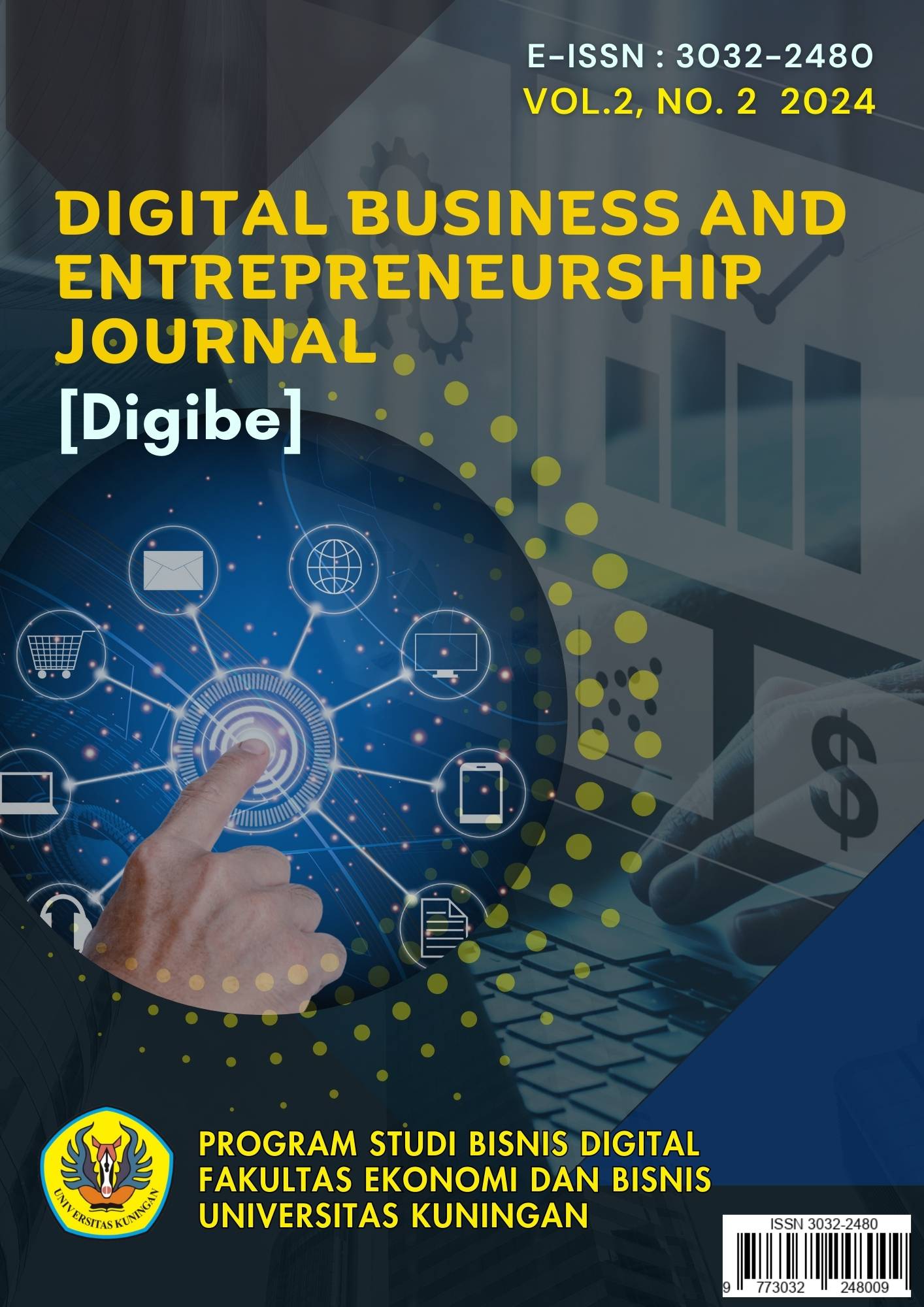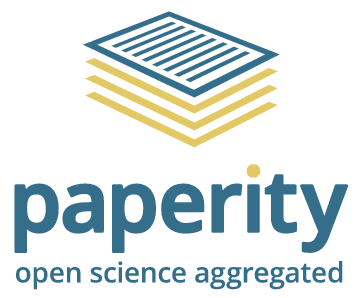DAMPAK SCRM PADA ENGAGEMENT, REVISIT INTENTION DAN LOYALTY PADA KONSUMEN CAFE DI PONTIANAK
DOI:
https://doi.org/10.25134/digibe.v2i2.28Abstract
Abstrak
Perkembangan cafe di Pontianak telah mengalami pertumbuhan pesat dan menunjukkan tren yang terus berkembang seiring gaya hidup masyarakat. Pemasaran modern seperti Customer Relationship Management (CRM) menjadi krusial, terutama melalui pemanfaatan Social CRM (SCRM) yang mengintegrasikan media sosial. Penelitian ini bertujuan untuk menginvestigasi peran SCRM dalam meningkatkan engagement, loyalitas, dan niat berkunjung kembali pelanggan cafe di Pontianak. Metode kuantitatif dengan pengujian berbasis SEM digunakan dengan mengumpulkan data 216 responden melalui survei kuesioner di kalangan mahasiswa dari beberapa perguruan tinggi di Pontianak yang merupakan konsumen aktif cafe. Hasil penelitian menunjukkan bahwa SCRM berpengaruh signifikan statistik terhadap engagement dan niat berkunjung kembali, tetapi tidak langsung memengaruhi loyalitas. Temuan ini mengindikasikan pentingnya fokus pada engagement melalui sosial media untuk mempengaruhi keputusan berkunjung kembali konsumen. Implikasi penelitian ini untuk praktisi adalah perlunya strategi SCRM yang terarah untuk memaksimalkan interaksi dan keterlibatan konsumen melalui sosial media guna membangun hubungan yang berkelanjutan.
Kata kunci: SCRM, Revisit Intention, Loyalty
Abstract
The rapid growth of cafes in Pontianak shows an evolving trend that aligned with coffee consumption lifestyles. Modern marketing, particularly Customer Relationship Management (CRM), is essential, particullary through social media in Social CRM (SCRM). This study aims to investigate the role of SCRM in enhancing engagement, loyalty, and revisit intention among cafe customers in Pontianak. A quantitative method employing structural equation modeling (SEM) was utilized. 216 data was recorded from respondents via questionnaire surveys among students from several Pontianak universities, which was active cafe consumers. Findings indicate that SCRM statistically significant in impacting engagement and revisit intention, but not loyalty. These results underscore the importance of focusing on customer engagement to influence customers revisit intention. Practical implications highlight the necessity for more targeted SCRM strategies to maximize consumer interaction and engagement through social media platforms, fostering lifetime value relationships.
Keyword: SCRM, Revisit Intention, Loyalty
References
Arora, L., Singh, P., Bhatt, V., & Sharma, B. (2021). Understanding and managing customer engagement through social customer relationship management. Journal of Decision Systems, 30(2–3), 215–234. https://doi.org/10.1080/12460125.2021.1881272
Bartoloni, S., & Ancillai, C. (2023). Twenty years of social media marketing: A systematic review, integrative framework, and future research agenda. International Journal of Management Reviews, March 2022, 1–23. https://doi.org/10.1111/ijmr.12360
Busalim, A. H., Ghabban, F., & Hussin, A. R. C. (2021). Customer engagement behaviour on social commerce platforms: An empirical study. Technology in Society, 64, 101437. https://doi.org/10.1016/j.techsoc.2020.101437
Buttle, F., & Maklan, S. (2019). Customer Relationship Management (4th ed.). Routledge. https://doi.org/10.1201/9780203997512
Creswell, J. W. (2014). Research Design, Qualitative, Quantitative, and Mixed Methods Approaches (4th ed.). Sage Publishing.
Disdukcapil. (2023). Jumlah Penduduk Kota Pontianak 2023. https://disdukcapil.pontianak.go.id/download/jumlah-penduduk-semester-i-tahun-2023
Hair, J., Hult, G. T. M., Ringle, C. M., Sarstedt, M., & Thiele, K. O. (2017). Mirror, mirror on the wall: a comparative evaluation of composite-based structural equation modeling methods. Journal of the Academy of Marketing Science, 45(5), 616–632. https://doi.org/10.1007/s11747-017-0517-x
Hair, Joe F., Matthews, L. M., Matthews, R. L., & Sarstedt, M. (2017). PLS-SEM or CB-SEM: updated guidelines on which method to use. International Journal of Multivariate Data Analysis, 1(2), 107. https://doi.org/10.1504/ijmda.2017.10008574
Hair, Joseph F., Hult, G. T., Ringle, C., & Sarstedt, M. (2017). A Primer on Partial Least Squares Structural Equation Modeling (PLS-SEM) - Joseph F. Hair, Jr., G. Tomas M. Hult, Christian Ringle, Marko Sarstedt. In Sage.
Ibrahim, B. (2021). Social Media Marketing Activities and Brand Loyalty: A Meta-Analysis Examination. Journal of Promotion Management, 28(1), 60–90. https://doi.org/10.1080/10496491.2021.1955080
Ibrahim, J. (2022). Hampir 800 Warkop di Pontianak, Edi Sebut Banyak Serap Tenaga Kerja. Pontianak.Go.Id. https://pontianak.go.id/pontianak-hari-ini/berita/Hampir-800-Warkop-di-Pontianak,-Edi-Sebut-Banyak-Serap-Tenaga-Kerja
Ibrahim, Y., Abbas, T., & Kamal, M. (2021). The Impact of Online Communities-based Social Customer Relationship Management (S-CRM) on Customer Loyalty and Brand Image on Hotels. Journal of Association of Arab Universities for Tourism and Hospitality, 0(0), 0–0. https://doi.org/10.21608/jaauth.2021.84867.1202
Kevin Adriel, Sudarman, M. B., Smith, B., & Mustikasari, F. (2024). the Effect of Social Customer Relationships Management on Customer Loyalty in Indonesia’S E-Commerce. International Journal of Professional Business Review, 9(3), e04319. https://doi.org/10.26668/businessreview/2024.v9i3.4319
Kumar, V., & Reinartz, W. (2018). Customer Relationship Management: Concept, Strategy, and Tools, 3rd Edition. In Customer Relationship Management: Concept, Strategy, and Tools, 3Rd Edition.
Kwame Opoku, E., Tham, A., Morrison, A. M., & Wang, M. jung S. (2023). An exploratory study of the experiencescape dimensions and customer revisit intentions for specialty urban coffee shops. British Food Journal, 125(5), 1613–1630. https://doi.org/10.1108/BFJ-04-2022-0361
Malki, D., Bellahcene, M., Latreche, H., Terbeche, M., & Chroqui, R. (2023). How social CRM and customer satisfaction affect customer loyalty. Spanish Journal of Marketing - ESIC. https://doi.org/10.1108/SJME-09-2022-0202
Matthews, M. (2018). PLS-SEM: The Holy Grail for Advanced Analysis. Marketing Management Journal, 28(1), 1–13.
Medjani, F., & Barnes, S. J. (2021). Understanding the Implementation of Social Customer Relationship Management in the North African Context: An Integrated Theory Perspective. Journal of Global Information Technology Management, 24(4), 299–318. https://doi.org/10.1080/1097198X.2021.1993726
Norman, G. (2010). Likert scales, levels of measurement and the “laws” of statistics. Advances in Health Science Education, 15, 625–632. https://doi.org/10.1007/s10459-010-9222-y
Prasetyo, Y. T., Castillo, A. M., Salonga, L. J., Sia, J. A., Chuenyindee, T., Young, M. N., Persada, S. F., Miraja, B. A., & Redi, A. A. N. P. (2021). Factors influencing repurchase intention in drive-through fast food: A structural equation modeling approach. Foods, 10(6). https://doi.org/10.3390/foods10061205
Prentice, C., Wang, X., Lin, X., Prentice, C., & Wang, X. (2018). An Organic Approach to Customer Engagement and Loyalty. Journal of Computer Information Systems, 00(00), 1–10. https://doi.org/10.1080/08874417.2018.1485528
Qalati, S. A., Li, W., Ahmed, N., Mirani, M. A., & Khan, A. (2021). Examining the factors affecting sme performance: the mediating role of social media adoption. Sustainability (Switzerland), 13(1), 1–24. https://doi.org/10.3390/su13010075
Rea, L. M., & Parker, R. A. (2014). Designing and conducting survey research : a comprehensive guide. Wiley.
Ringle, C. M., Da Silva, D., & Bido, D. D. S. (2014). Structural Equation Modeling with the Smartpls. Revista Brasileira de Marketing, 13(02), 56–73. https://doi.org/10.5585/remark.v13i2.2717
Sekaran, U., & Bougie, R. (2016). Research Methods for Business (7th ed.). Wiley.
Downloads
Published
How to Cite
Issue
Section
License
Copyright (c) 2024 Digital Business and Entrepreneurship Journal

This work is licensed under a Creative Commons Attribution-ShareAlike 4.0 International License.
Digital Business and Entrepreneurship Journal allow reuse and remixing of its content, in accordance with a CC BY-SA 4.0 which follow international Lisence. This license lets others to:
Share — copy and redistribute the material in any medium or format
Adapt — remix, transform, and build upon the material, for any purpose, even commercially.
The licensor cannot revoke these freedoms as long as you follow the license terms.
Under the following terms:
Attribution — You must give appropriate credit, provide a link to the license, and indicate if changes were made. You may do so in any reasonable manner, but not in any way that suggests the licensor endorses you or your use.
ShareAlike — If you remix, transform, or build upon the material, you must distribute your contributions under the same license as the original.
No additional restrictions — You may not apply legal terms or technological measures that legally restrict others from doing anything the license permits.
Notices:
You do not have to comply with the license for elements of the material in the public domain or where your use is permitted by an applicable exception or limitation.
No warranties are given. The license may not give you all of the permissions necessary for your intended use. For example, other rights such as publicity, privacy, or moral rights may limit how you use the material.














